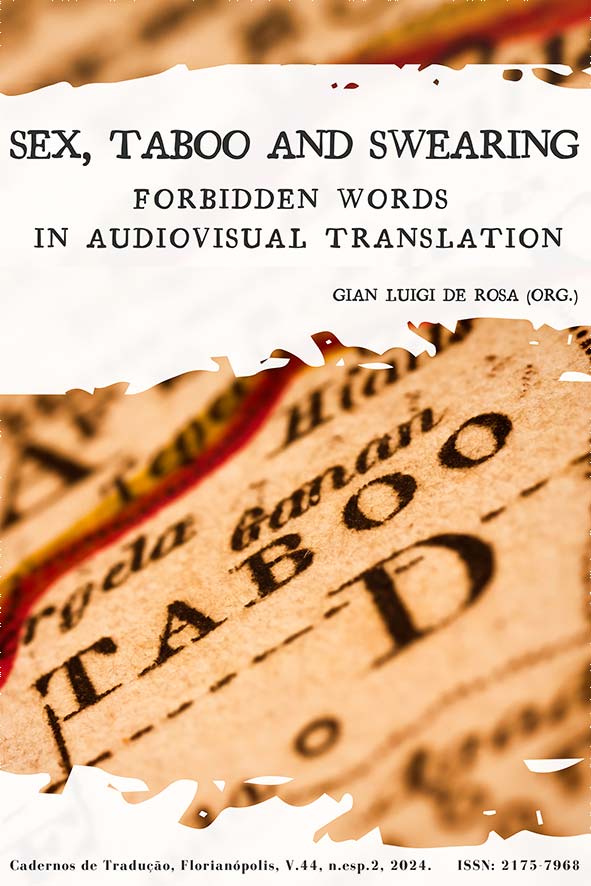Call them by their names: sexualidad, homoerotismo y traducción audiovisual
DOI:
https://doi.org/10.5007/2175-7968.2024.e99147Palabras clave:
cuir, LGBTQ+, doblaje, español neutroResumen
En el presente artículo se analiza la traducción del homoerotismo mediante el doblaje. El estudio parte del supuesto de que la teleficción contemporánea integra distintas dimensiones de la sexualidad como parte de la narrativa y la construcción de los personajes. El caso de estudio es Looking, una serie de drama y comedia producida por HBO y transmitida originalmente entre 2014 y 2016. Esta serie de televisión es un caso relevante para identificar cómo la interacción entre recursos semióticos visuales y lingüísticos son fundamentales para sostener el relato. El objetivo del estudio es doble: identificar las interacciones semióticas entre los modos visuales y el código lingüístico en escenas que involucran conversaciones sexuales o intimidad entre personajes masculinos en Looking; y contrastar cómo las traducciones para el doblaje al español neutro (para América Latina) y al español peninsular contribuyeron o transformaron la representación del deseo entre hombres. Los hallazgos se analizan en el contexto de los estudios de traducción cuir y de género, así como en la teoría de los afectos. Un argumento general derivado del estudio es que la neutralidad y el tabú conllevan componentes prescriptivos que deben cuestionarse para comprender cómo circulan actualmente los imaginarios sexuales mediante los medios y la traducción.
Citas
Ahmed, S. (2014). The Cultural Politics of Emotion. Edinburgh University Press.
Ahmed, S. (2015). La política cultural de las emociones (C. Olivares Mansuy, Trad.). Universidad Nacional Autónoma de México.
Albertson, C. (2014). Looking—Who Are We Now? Contexts, 13(4), 54–56. https://doi.org/10.1177/1536504214558218
Allan, K. (2018). Taboo Words and Language: An Overview. En K. Allan (Ed.), The Oxford Handbook of Taboo Words and Language (pp. 1–29). Oxford University Press. https://doi.org/10.1093/oxfordhb/9780198808190.013.1
Ang, R. (2024, January 26). The Oral History of Looking, HBO’s Short-Lived, Groundbreaking Gay Series. GQ. https://www.gq.com/story/the-oral-history-of-looking
Austin, J. L. (1962). How to do Things with Words. Oxford University Press.
Ávila-Cabrera, J. J. (2015). An Account of the Subtitling of Offensive and Taboo Language in Tarantinos Screenplays. Sendebar, 26, 37–56.
Ávila-Cabrera, J. J. (2016a). The subtitling of Offensive and Taboo Language into Spanish of Inglourious Basterds: A Case Study. Babel, 62(2), 211–232. https://doi.org/10.1075/babel.62.2.03avi
Ávila-Cabrera, J. J. (2016b). The Treatment of Offensive and Taboo Terms in The Subtitling of Reservoir Dogs into Spanish. Trans, 20, 25–40. https://doi.org/10.24310/trans.2016.v0i20.3145
Ávila-Cabrera, J. J. (2023). The Challenge of Subtitling Offensive and Taboo Language into Spanish. A Theoretical and Practical Guide. Multilingual Matters.
Baer, B. J. (2011). Translating Queer Texts in Soviet Russia: A Case Study in Productive Censorship. Translation Studies, 4(1), 21–40. https://doi.org/10.1080/14781700.2011.528680
Baer, B. J. (2013). Now You See it: Gay (in)visibility and the Performance of Post-Soviet Identity. En N. Fejes & A. P. Balogh (Eds.), Queer Visibility in Post-Socialist Cultures (pp. 35 –55). Intellect Ltd.
Baer, B. J. (2017a). A Poetics of Evasion. The Queer Translations of Aleksei Apukhtin. En B. J. Epstein & R. Gillett (Eds.), Queer in Translation (pp. 52–63). Routledge.
Baer, B. J. (2017b). Beyond either/or: Confronting the Fact of Translation in Global Sexuality Studies. En B. J. Baer & K. Kaindl (Eds.), Queering Translation, Translating the Queer. Theory, Practice, Activism (pp. 38–57). Routledge.
Baer, B. J. (2021). Queer Theory and Translation Studies. Languages, Politics, Desire. Routledge.
Barthes, R. (1970). Introducción al análisis estructural de los relatos. En R. Barthes, A. J. Greimas, C. Bremond, J. Gritti, V. Morin, C. Metz, T. Todorov & G. Genette (Eds.), Análisis estructural del relato (pp. 9–43). Editorial Tiempo Contemporáneo.
Bernabo, L. (2022). (De/Re)Constructing LGBT Characters in Latin America: The Implications of Mexican Dubbing for Translating Marginalized Identities. Communication, Culture and Critique, 15(1), 36–51. https://doi.org/10.1093/ccc/tcab045
Botella Tejera, C., & Ogea Pozo, M. del M. (2022). ¿Por qué lo llaman amor cuando quieren decir sexo? La traducción de las relaciones amorosas en las series de adolescentes de hoy. En M. M. Galindo Merino & M. Méndez Santos (Eds.), La lingüística del amor (pp. 201–228). Pie de Página.
Burneo Salazar, C. (2018). Sobre los manifiestos: la traducción como afirmación de la diferencia. Jornadas Internacionales de Traducción Comparada. Variedades Regionales en las Lenguas de Traducción. https://cvc.cervantes.es/lengua/actas_jitc/22_salazar.htm
Butler, J. (1990). Gender Trouble. Feminism and the Subversion of Identity. Routledge.
Cante, R., & Restivo, A. (2004). The Cultural-Aesthetic Specificities of All-male Moving-Image Pornography. En L. Williams (Ed.), Porn Studies (pp. 142–166). Duke University Press.
Chamberlain, L. (1988). Gender and the Metaphorics of Translation. Signs, 13(3), 454–472.
Chen, X. (2023). Reframing Queer Pop through Media Paratexts: Translation of Chinese TV Drama World of Honor in Cyberspace. Translation Studies, 16(3), 1–15. https://doi.org/10.1080/14781700.2023.2219264
Crespo-Fernández, E. (2018). Taboos in Speaking of Sex and Sexuality. En K. Allan (Ed.), The Oxford Handbook of Taboo Words and Language. Oxford University Press.
De Marco, M. (2012). Audiovisual Translation through a Gender Lens. Rodopi.
Domínguez-Ruvalcaba, H. (2009). From Fags to Gays. Political Adaptations and Cultural Translations in the Mexican Liberation Movement. En L. Egan & M. K. Long (Eds.), Mexico Reading the United States (pp. 116–134). Vanderbilt University Press.
Domínguez-Ruvalcaba, H. (2016). Translating the Queer. Body Politics and Transnational Conversations. Zed Books.
Dyer, R. (1998). Stars. British Film Institute Publishing.
Edelman, L. (1994). Homographesis. Essays in Gay Literature and Cultural Theory. Routledge.
Fontanille, J. (2008). Soma y sema. Figuras semióticas del cuerpo (D. Blanco Lopez, Trad.). Fondo Editorial de la Universidad de Lima.
Foucault, M. (1991). Historia de la sexualidad 1. La voluntad de saber (T. Segovia, Trad.). Siglo XXI.
Foucault, M. (1994a). De l’amitié comme mode de vie. En M. Foucault (Ed.), Dits et écrits Vol. IV 1980-1988 (pp. 163–167). Gallimard.
Foucault, M. (1994b). Le triomphe social du plaisir sexuel. En M. Foucault (Ed.), Dits et écrits Vol. IV 1980-1988 (pp. 308–314). Gallimard.
Freud, S. (1986). Tótem y tabú. Algunas concordancias en la vida anímica de los salvajes y de los neuróticos (1913 [1912-13]) (J. L. Etcheverry, Trad.). En S. Freud (Ed.), Obras completas (pp. 1–164). Amorrortu Editores.
Fuentes-Luque, A. (2020). La traducción audiovisual en Venezuela: aspectos históricos, técnicos y profesionales. Sendebar, 31(1), 51–68. https://doi.org/10.30827/sendebar.v31i0.11802
Godard, B. (1990). Theorizing Feminist Discourse/Translation. Translation, History, Culture, 1, 87–96.
Godayol, P. (2008). Derrida y la teoría de la traducción en femenino. In P. Calefato & P. Godayol (Eds.), Traducción/género/poscolonialismo (pp. 67–74). La Crujía.
Godayol, P. (2013). Metaphors, Women and Translation: From les belles infidèles to la frontera. Gender and Language, 7(1), 97–116. https://doi.org/10.1558/genl.v7i1.97
Grosse, S. A. (2007). The Transformed Gay Self: The Male Body and its Scenic Presence as Sites of Gay Self-Enunciation. En H. Sauntson & S. Kyratzis (Eds.), Language, Sexualities and Desires. Cross-Cultural Perspectives (pp. 165–184). Palgrave Macmillan.
Guo, T. (2021). ‘Love is Love’ and ‘Love is Equal’, Fansubbing and Queer Feminism in China. En M. A. Bracke, J. C. Bullock, P. Morris & K. Schulz (Eds.), Translating Feminism (pp. 199-226). Palgrave Macmillan.
Guo, T., & Evans, J. (2020). Translational and Transnational Queer Fandom in China: the Fansubbing of Carol. Feminist Media Studies, 20(4), 515–529. https://doi.org/10.1080/14680777.2020.1754630
Haigh, A. (2016). Looking: The Movie [película]. HBO.
Hall, S. (1997). The Spectacle of the Other. En J. Evans, S. Hall & S. Nixon (Eds.), Representation: Cultural Representations and Signifying Practices (pp. 223–259). Sage Publications.
Hargraves, H. (2020). Looking. Smartphone Aesthetics. En E. Thompson & J. Mittel (Eds.), How to Watch Television (pp. 41–50). New York University.
Harvey, K. (1998). Translating Camp Talk. The Translator, 4(2), 295–320. https://doi.org/10.1080/13556509.1998.10799024
Harvey, K. (2000). Gay Community, Gay Identity and the Translated Text. TTR: Traduction, Terminologie, Rédaction, 13(1), 137–165. https://doi.org/https://doi.org/10.7202/037397ar
Iglesias Urquízar, J. (2021). Looking at Redefining Sex(uality). Reinforcing Sexual References in the Spanish Dubbing of Looking. Babel, 67(5), 579–598. https://doi.org/10.1075/babel.00240.urq
Jiang, M. (2022). Translating the Unspeakable: Activist Translation of Sexuality into Chinese via Social Media. The Translator, 29(3), 1–16. https://doi.org/10.1080/13556509.2022.2153433
La Fountain-Stokes, L. (2007). Queer Ducks, Puerto Rican Patos, and Jewish American Feygelekh: Birds and the Cultural Representation of Homosexuality. CENTRO Journal, 19(1), 192–229.
Lannan, M., Grant, D. M., Condon, S., & Haigh, A. (2014). Looking (Temporada 1) [serie de television]. Fair Harbor Productions & HBO.
Lannan, M., Grant, D. M., Condo, S., & Haigh, A. (2015). Looking (Temporada 2) [serie de televisión]. Fair Harbor Productions & HBO.
Larkosh, C. (2006). Two in Translation. The Multilingual Cartographies of Néstor Perlongher and Caio Fernando Abreu. En C. Larkosh (Ed.), Re-Engendering Translation. Transcultural Practice, Gender/Sexuality and the Politics of Alterity (pp. 72–90). Routledge.
Larkosh, C. (2007a). Forms of A-Dress: Performances of the Foreign and S-Other-n Flows of Transnational Identity. Social Dynamics, 33(2), 164–183. https://doi.org/10.1080/02533950708628766
Larkosh, C. (2007b). The Translator’s Closet: Editing Sexualities in Argentine Literary Culture. TTR: Traduction, Terminologie, Rédaction, 20(2), 63–88. https://doi.org/10.7202/018822ar
Larkosh, C. (2017). James S. Holmes, Translation Studies, and the Queer Ethics of The First Person. En J. Santaemilia (Ed.), Traducir para la igualdad sexual. Translating for Sexual Equality (pp. 157–172). Comares.
Lewis, E. S. (2010). “This is My Girlfriend, Linda” Translating Queer Relationships in Film: A Case Study of the Subtitles for Gia and a Proposal for Developing the Field of Queer Translation Studies. In Other Words: The Journal for Literary Translators, 3, 3–22.
Littau, K. (2011). First Steps Towards a Media History of Translation. Translation Studies, 4(3), 261–281. https://doi.org/10.1080/14781700.2011.589651
Manganas, N. (2018). Queer Fantasies, Queer Echoes: The Post-Closet Word of Looking. En V. McGollum & G. Monteverde (Eds.), HBO’s Original Voices. Race, Gender, and Power (pp. 57–68). Routledge.
Martínez Moreno, E. (2022). El español neutro en el doblaje latino. La imposición a través de luchas simbólicas. Global Media Journal México, 19(36), 1–26. https://doi.org/10.29105/gmjmx19.36-465
Martínez Pleguezuelos, A. J. (2018). Traducción e identidad sexual. Reescrituras audiovisuales desde la Teoría Queer. Editorial Comares.
Mays, V. M., Cochran, S. D., Bellinger, G., Smith, R. G., Henley, N., Daniels, M., Tibbits, T., Vitorianne, G., Kwasi, O., & Birt, D. (1992). The language of Black Gay Men’s Sexual Behavior‐Implications for AIDS Risk Reduction. The Journal of Sex Research, 29(3), 425–234. https://doi.org/10.1080/00224499209551657
Mira, A. (1998). Pushing the Limits of Faithfulness a Case for Gay Translation. En J. Boase-Beier (Ed.), The Practices of Literary Translation: Constraints and Creativity (pp. 109–124). Routledge.
Mira, A. (2023). Entre la cámara y la carne. El cine homoerótico en 25 películas. Egales.
Mittel, J. (2015). Complex TV. The Poetics of Contemporary Television Storytelling. New York University Press.
Newell, S. (2018). The Affectiveness of Symbols: Materiality, Magicality, and the Limits of the Antisemiotic Turn. Current Anthropology, 59(1), 1–22. https://doi.org/10.1086/696071
Nguyen, T. H. (2004). The Resurrection of Brandon Lee: The Making of a Gay Asian American Porn Star. En L. Williams (Ed.), Porn Studies (pp. 223–270). Duke University Press.
O’Connor, A. (2021). Media and Translation. Historical Intersections. In E. Bielsa (Ed.), The Routledge Handbook of Translation and Media (pp. 13–27). Routledge.
Ogea Pozo, M. del M., & Botella Tejera, C. (2023). Sexo, amor y palabras: la traducción para doblaje de las series de adolescentes. Hikma, 22(1), 249–275. https://doi.org/10.21071/hikma.v22i1.15165
Pierce, J. M. (2020). El impasse deseante: traducciones, malentendidos y racismo en Chile. Post(s), 6(1). https://doi.org/10.18272/post(s).v6i1.1884
Pierce, J. M., Viteri, M. A., Trávez, D. F., Vidal-Ortiz, S., & Martínez-Echazábal, L. (2021). Introduction: Cuir/Queer Américas: Translation, Decoloniality, and the Incommensurable. GLQ: A Journal of Lesbian and Gay Studies, 27(3), 321–327. https://doi.org/10.1215/10642684-8994028
Ranzato, I. (2012). Gayspeak and Gay Subjects in Audiovisual Translation: Strategies in Italian Dubbing. Meta: Journal Des Traducteurs, 57(2), 369–384. https://doi.org/10.7202/1013951ar
Real Academia Española. (n.d.) Follar. Diccionario de la lengua española. https://dle.rae.es/follar
Rodrigues-Júnior, A. S. (2007). A representação de personagens gays na coletânea de contos Stud e em sua tradução As Aventuras de um Garoto de Programa. Trabalhos Em Linguística Aplicada, 46, 263–281.
Rodrigues-Júnior, A. S., & Barbara, L. (2013). Linguistic constructions of Appraisal in the Novel The Picture of Dorian Gray and its Brazilian Translation and Adaptations: An Exploratory Analysis. Revista Brasileira de Linguística Aplicada, 13(1), 259–285. https://doi.org/10.1590/s1984-63982013000100013
Sáez, J., & Carrascosa, S. (2011). Por el culo. Políticas anales. Egales.
Santaemilia, J. (2005). The Translation of Sex/The Sex of Translation: Fanny Hill in Spanish. En J. Santaemilia (Ed.), Gender, Sex and Translation. The Manipulation of Identities (pp. 117–136). Routledge.
Santaemilia, J. (2008). The Translation of Sex-Related Language: The Danger(S) of Self-censorship(s). TTR: Traduction, Terminologie et Redaction, 21(2), 221–252. https://doi.org/10.7202/037497ar
Scandura, G. (2020). Estudio descriptivo del español neutro del doblaje en series de ficción infantiles y juveniles: ¿estandarización, política lingüística o censura? [Tesis doctoral]. Universitat Jaume I. http://hdl.handle.net/10803/671587
Tinkcom, M. (2002). Working like a Homosexual. Camp, Capital, Cinema. Duke University Press.
Toledano Buendía, C. (2002). Recepción de Fanny Hill en España: Estudio Preliminar. Atlantis, 24(2), 215–227.
Toledano Buendía, C. (2003). La traducción de la obscenidad. La Página Ediciones.
Toto, P. A. (2009). “Less about Sex, More about Shopping”: Will & Grace e il linguaggio gay. En S. Petrilli & D. Buchbinder (Eds.), Masculinities. Identità maschili e appartenenze culturali (pp. 153–158). Mimesis.
Vidal Claramonte, M. C. A. (2004). En los límites de la traducción. Editorial Comares.
Villanueva-Jordán, I. (2021a). La traducción de masculinidades gay en la teleficción: análisis multimodal del doblaje latinoamericano y peninsular de la serie de televisión Looking [Tesis doctoral]. Universitat Jaume I. http://hdl.handle.net/10757/658720
Villanueva-Jordán, I. (2021b). Metasíntesis de estudios publicados sobre traducción audiovisual y estudios LGBTQ+ (2000-2020): dimensiones teóricas y conceptuales. Meta: Journal Des Traducteurs, 66(3), 557–579. https://doi.org/https://doi.org/10.7202/1088350ar
Villanueva-Jordán, I., & Chaume, F. (2024, 28 de enero). Línea temporal sobre traducción audiovisual y estudios LGBTQ+. https://trujamancia.com/linea-del-tiempo/
Villanueva-Jordán, I., & Martínez Pleguezuelos, A. J. (2023). Miradas sobre lo queer/cuir en la traducción iberoamericana. Mutatis Mutandis. Revista Latinoamericana de Traducción, 16(1), 3–17. https://doi.org/10.17533/udea.mut/v16n1a01
von Flotow, L. (1991). Feminist Translation: Contexts, Practices and Theories. TTR : Traduction, Terminologie, Rédaction, 4(2), 69–84. https://doi.org/10.7202/037094ar
von Flotow, L. (1997). Translation and Gender. Translating in the “Era of Feminism”. St Jerome Publishing & University of Ottawa Press.
Walcott, R. (2019). Black Cumjoy: Pleasure and a Racist Virus. En R. Varghese (Ed.), PrEP, Paedagogy and the Politics of Barebacking (pp. 95–114). University of Regina Press.
Wells, J. W. (1989). Sexual Language Usage in Different Interpersonal Contexts: A Comparison of Gender and Sexual Orientation. Archives of Sexual Behavior, 18(2), 127–143. https://doi.org/10.1007/BF01543119
Descargas
Publicado
Cómo citar
Número
Sección
Licencia
Derechos de autor 2024 Cadernos de Tradução

Esta obra está bajo una licencia internacional Creative Commons Atribución 4.0.
Declaración de Derecho de Autor
Los autores conservan sus derechos de autor y conceden a la revista el derecho a la primera publicación bajo la Licencia Creative Commons Attribution, que permite que se comparta el trabajo reconociéndose la autoría y publicación inicial en esta revista.
Los autores están autorizados a asumir contratos adicionales por separado para la distribución no exclusiva de la versión del trabajo publicada en esta revista (por ej.: publicar en un repositorio institucional o como capítulo de libro, reconociéndose la autoría y publicación inicial en esta revista).





















































